formerly eScholarship Editions


|
|
|
|
Browse by Title
All Titles | Public Titles
A | B | C | D | E | F | G | H | I | J | K | L | M | N | O | P | Q | R | S | T | U | V | W | Y | Z | OTHERYour request for titles beginning with D found 71 book(s). | Modify Search | Displaying 1 - 20 of 71 book(s) | |
| 1. |  | Title: Daggers of faith: thirteenth-century Christian missionizing and Jewish response Author: Chazan, Robert Published: University of California Press, 1989 Subjects: Religion Publisher's Description: Our understanding of both Jewish history and the history of Western civilization is deepened by this finely balanced account of Christian missionizing among the Jews. Arguing that until the thirteenth century Western Christendom showed little serious commitment to converting the Jews, Robert Chazan proceeds to detail the special circumstances of that critical century in European history. The Roman Catholic Church, characterized at that time by a remarkable combination of vitality and confidence on the one hand and deep-seated insecurities on the other, embarked on its first vigorous campaign to convert the Jews in significant numbers.Chazan examines the new missionizing endeavor in its formative stages, roughly from 1240 to 1280, and analyzes Christian efforts to convince Jews of the truth of Christianity and, at the same time, of the nullity of the Jewish religious tradition. At least as interesting is his investigation of the Jewish lines of response. These ranged from the postures adopted in public debate to the reassurances penned by Jewish leaders for the eyes and ears of their followers only. Although few Jews were converted by the first wave of this new missionizing thrust, it ranked high among the developments that eventually sapped the strength of late medieval European Jewry. [brief] Similar Items |
| 2. |  | Title: Dangerous emotions Author: Lingis, Alphonso 1933- Published: University of California Press, 2000 Subjects: Philosophy | Cultural Anthropology | Literature | Social and Political Thought | Travel Publisher's Description: Alphonso Lingis is an original among American philosophers. An eloquent and insightful commentator on continental philosophers, he is also a phenomenologist who has gone to live in many lands. Dangerous Emotions continues the line of inquiry begun in Abuses , taking the reader to Easter Island, Japan, Java, and Brazil as Lingis poses a new range of questions and brings his extraordinary descriptive skills to bear on innocence and the love of crime, the relationships of beauty with lust and of joy with violence and violation. He explores the religion of animals, the force in blessings and in curses. When the sphere of work and reason breaks down, and in catastrophic events we catch sight of cosmic time, our anxiety is mixed with exhilaration and ecstasy. More than acceptance of death, can philosophy understand joy in dying? Haunting and courageous, Lingis's writing has generated intense interest and debate among gender and cultural theorists as well as philosophers, and Dangerous Emotions is certain to introduce his work to an ever broader circle of readers. [brief] Similar Items |
| 3. | 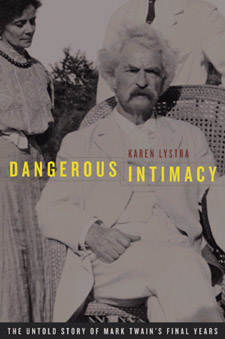 | Title: Dangerous intimacy: the untold story of Mark Twain's final years Author: Lystra, Karen Published: University of California Press, 2004 Subjects: Literature | Autobiographies and Biographies | Twain | American Literature | American Studies Publisher's Description: The last phase of Mark Twain's life is sadly familiar: Crippled by losses and tragedies, America's greatest humorist sank into a deep and bitter depression. It is also wrong. This book recovers Twain's final years as they really were - lived in the shadow of deception and prejudice, but also in the light of the author's unflagging energy and enthusiasm. Dangerous Intimacy relates the story of how, shortly after his wife's death in 1904, Twain basked in the attentions of Isabel Lyon, his flirtatious - and calculating - secretary. Lyon desperately wanted to marry her boss, who was almost thirty years her senior. She managed to exile Twain's youngest daughter, Jean, who had epilepsy. With the help of Twain's assistant, Ralph Ashcroft, who fraudulently acquired power of attorney over the author's finances, Lyon nearly succeeded in assuming complete control over Twain's life and estate. Fortunately, Twain recognized the plot being woven around him just in time. So rife with twists and turns as to defy belief, the story nonetheless comes to undeniable, vibrant life in the letters and diaries of those who witnessed it firsthand: Katy the housekeeper, Jean, Lyon, and others whose own distinctive, perceptive, often amusing voices take us straight into the heart of the Clemens household. Just as Twain extricated himself from the lies, prejudice, and self-delusion that almost turned him into an American Lear, so Karen Lystra liberates the author's last decade from a century of popular misunderstanding. In this gripping book we at last see how, late in life, this American icon discovered a deep kinship with his youngest child and continued to explore the precarious balance of love and pain that is one of the trademarks of his work. [brief] Similar Items |
| 4. | 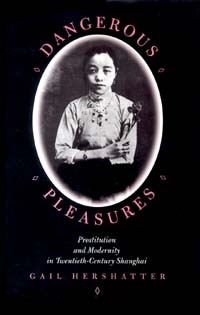 | Title: Dangerous pleasures: prostitution and modernity in twentieth-century Shanghai Author: Hershatter, Gail Published: University of California Press, 1997 Subjects: History | Women's Studies | China Publisher's Description: This pioneering work examines prostitution in Shanghai from the late nineteenth century to the present. Drawn mostly from the daughters and wives of the working poor and declassè elites, prostitutes in Shanghai were near the bottom of class and gender hierarchies. Yet they were central figures in Shanghai urban life, entering the historical record whenever others wanted to appreciate, castigate, count, regulate, cure, pathologize, warn about, rescue, eliminate, or deploy them as a symbol in a larger social panorama.Over the past century, prostitution has been understood in many ways: as a source of urbanized pleasures, a profession full of unscrupulous and greedy schemers, a changing site of work for women, a source of moral danger and physical disease, a marker of national decay, and a sign of modernity. For the Communist leadership of the 1950s, the elimination of prostitution symbolized China's emergence as a strong, healthy, and modern nation. In the past decade, as prostitution once again has become a recognized feature of Chinese society, it has been incorporated into a larger public discussion about what kind of modernity China should seek and what kind of sex and gender arrangements should characterize that modernity.Prostitutes, like every other non-elite group, did not record their own lives. How can sources generated by intense public argument about the "larger" meanings of prostitution be read for clues to those lives? Hershatter makes use of a broad range of materials: guidebooks to the pleasure quarters, collections of anecdotes about high-class courtesans, tabloid gossip columns, municipal regulations prohibiting street soliciting, police interrogations of streetwalkers and those accused of trafficking in women, newspaper reports on court cases involving both courtesans and streetwalkers, polemics by Chinese and foreign reformers, learned articles by Chinese scholars commenting on the world history of prostitution and analyzing its local causes, surveys by doctors and social workers on sexually transmitted disease in various Shanghai populations, relief agency records, fictionalized accounts of the scams and sufferings of prostitutes, memoirs by former courtesan house patrons, and interviews with former officials and reformers.Although a courtesan may never set pen to paper, we can infer a great deal about her strategizing and working of the system through the vast cautionary literature that tells her customers how not to be defrauded by her. Newspaper accounts of the arrests and brief court testimonies of Shanghai streetwalkers let us glimpse the way that prostitutes positioned themselves to get the most they could from the legal system. Without recourse to direct speech, Hershatter argues, these women have nevertheless left an audible trace. Central to this study is the investigation of how things are known and later remembered, and how, later still, they are simultaneously apprehended and reinvented by the historian. [brief] Similar Items |
| 5. | 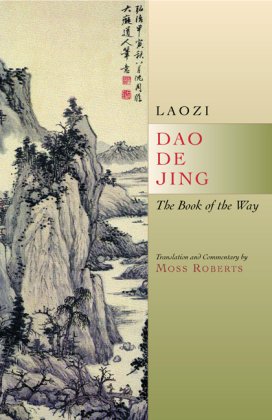 | Title: Dao de jing: the book of the way Author: Roberts, Moss 1937- Published: University of California Press, 2001 Subjects: Religion | China | Asian History | Asian Literature | Philosophy Publisher's Description: Dao De Jing is one of the richest, most suggestive, and most popular works of philosophy and literature. Composed in China between the late sixth and the late fourth centuries b.c., its enigmatic verses have inspired artists, philosophers, poets, religious thinkers, and general readers down to our own times. This new translation, both revelatory and authentic, captures much of the beauty and nuance of the original work. In an extensive and accessible commentary to his translation, Moss Roberts reveals new depths of Dao De Jing. This edition is distinguished by the literary quality of the translation, its new renderings for a number of the stanzas, and by Roberts's knowledgeable contextualizations. Utilizing recently discovered manuscripts and Chinese scholarship based on them, he is able to shed new light on the work's historical and philosophical contexts. This translation shows that Dao De Jing is far more than a work of personal inspiration; it is also a work of universal scope that makes penetrating comments on politics, statecraft, cosmology, aesthetics, and ethics. Roberts brings these themes to our attention, shows how they are integrated into the work as a whole, and demonstrates the relevance of these topics for our own times. [brief] Similar Items |
| 6. | 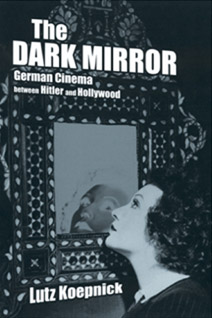 | Title: The dark mirror: German cinema between Hitler and Hollywood Author: Koepnick, Lutz P. (Lutz Peter) Published: University of California Press, 2002 Subjects: Cinema and Performance Arts | German Studies | Music | Film Publisher's Description: Lutz Koepnick analyzes the complicated relationship between two cinemas - Hollywood's and Nazi Germany's - in this theoretically and politically incisive study. The Dark Mirror examines the split course of German popular film from the early 1930s until the mid 1950s, showing how Nazi filmmakers appropriated Hollywood conventions and how German film exiles reworked German cultural material in their efforts to find a working base in the Hollywood studio system. Through detailed readings of specific films, Koepnick provides a vivid sense of the give and take between German and American cinema. [brief] Similar Items |
| 7. | 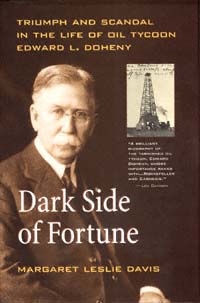 | Title: Dark side of fortune: triumph and scandal in the life of oil tycoon Edward L. Doheny Author: Davis, Margaret L Published: University of California Press, 1998 Subjects: History | California and the West | American Studies | Cultural Anthropology | Autobiographies and Biographies Publisher's Description: Dark Side of Fortune contains all the elements of a Hollywood thriller. Filling in one of the most important gaps in the history of the American West, Margaret Leslie Davis's riveting biography follows Edward L. Doheny's fascinating story from his days as an itinerant prospector in the dangerous jungles of Mexico, where he built the $100-million oil empire that ushered in the new era of petroleum. But it was a tale that ended in tragedy, when - at the peak of his economic power - Doheny was embroiled in the notorious Teapot Dome scandal and charged with bribing the U.S. Secretary of the Interior.Few captains of industry have matched Doheny's drive to succeed and his far-reaching ambition. Drawn to the West in search of fortune, he failed at prospecting before finding oil in a smelly, tar-befouled lot in Los Angeles in 1892. Certain that the substance had commercial value, he envisioned steamships and locomotives no longer powered by coal, but by oil. After developing massive oil wells in Mexico, Doheny built an international oil empire that made him one of the wealthiest men in the world. But in 1924 the scandal of Teapot Dome engulfed him. As accusations mounted, he hired America's top legal talent for his defense. During the ten-year-long litigation, Doheny's only son was mysteriously murdered by a family confidant. The government's case against Doheny ended in an astounding jury decision: The cabinet official accused of taking a bribe from Doheny was found guilty and sent to prison, yet Doheny was fully acquitted. Despite the verdict, the scandal had overshadowed the achievements of a lifetime, and he died in disgrace in 1935.Margaret Leslie Davis recreates the legal drama and adds details of behind-the-scenes strategy gleaned from the personal diaries and archives of Doheny's famed defense attorneys. Previously hidden personal correspondence adds to this first complete portrait of the man and answers questions about Doheny that have eluded historians for almost seventy-five years. [brief] Similar Items |
| 8. | 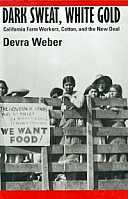 | Title: Dark sweat, white gold: California farm workers, cotton, and the New Deal Author: Weber, Devra 1946- Published: University of California Press, 1994 Subjects: History | Californian and Western History | Latino Studies | Labor Studies | California and the West | African History Publisher's Description: In her incisive analysis of the shaping of California's agricultural work force, Devra Weber shows how the cultural background of Mexican and, later, Anglo-American workers, combined with the structure of capitalist cotton production and New Deal politics, forging a new form of labor relations. She pays particular attention to Mexican field workers and their organized struggles, including the famous strikes of 1933.Weber's perceptive examination of the relationships between economic structure, human agency, and the state, as well as her discussions of the crucial role of women in both Mexican and Anglo working-class life, make her book a valuable contribution to labor, agriculture, Chicano, Mexican, and California history. [brief] Similar Items |
| 9. | 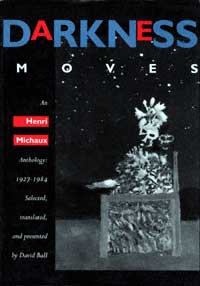 | Title: Darkness moves: an Henri Michaux anthology, 1927-1984 Author: Michaux, Henri 1899- Published: University of California Press, 1994 Subjects: Literature | Literature in Translation Publisher's Description: Henri Michaux defies common critical definition. Critics have compared his work to such diverse artists as Kafka, Goya, Swift, Klee, and Beckett. Allen Ginsberg called Michaux "genius," and Jorge Luis Borges wrote that Michaux's work "is without equal in the literature of our time." This anthology contains substantial selections from almost all of Michaux's major works, most never before published in English, and allows readers to explore the haunting verbal and pictorial landscape of a twentieth-century visionary. [brief] Similar Items |
| 10. |  | Title: Darwin in Russian thought Author: Vucinich, Alexander 1914- Published: University of California Press, 1989 Subjects: Science | History and Philosophy of Science Publisher's Description: Darwin in Russian Thought represents the first comprehensive and systematic study of Charles Darwin's influence on Russian thought from the early 1860s to the October Revolution. While concentrating on the role of Darwin's theory in the development of Russian science and philosophy, Vucinich also explores the dominant ideological and sociological interpretations of evolutionary thought, providing a deft analysis of the views held by the leaders of Russian nihilism, populism, anarchism, and marxism.Darwin's thinking profoundly influenced intellectual discourse in Russia: it effected the emergence of "theoretical theology," a modern effort to provide theological responses to the revolutionary changes in the natural sciences, contributed to the evolution of a modern scientific community, and spurred the rapidly growing concern with the epistemological and ethical foundations of science in general. Scholarly battles were waged among the critics of Darwin - Karl von Baer, Nikolai Iakovlevich Danilevskii and Sergei Ivanovich Korzhinskii, and others - and the defenders of the faith.Vucinich is able to delineate the distinctive national characteristics of Russian Darwinism: the strong influence of Lamarckian thought, the delayed recognition of the contributions of genetics, the near-universal rejection of Social Darwinism, the early anticipation of the triumph of "evolutionary synthesis," and the heavy concentration on the social and moral aspects of evolutionary thought. Vividly argued and rich in detail, Darwin in Russian Thought provides a unique glimpse into the Russian psyche. [brief] Similar Items |
| 11. |  | Title: Dateline Soweto: travels with black South African reporters Author: Finnegan, William Published: University of California Press, 1995 Subjects: Media Studies | African Studies | Social Problems | Politics | African History Publisher's Description: Dateline Soweto documents the working lives of black South African reporters caught between the mistrust of militant blacks, police harrassment, and white editors who - fearing government disapproval - may not print the stories these reporters risk their lives to get. William Finnegan revisited seve . . . [more] Similar Items |
| 12. | 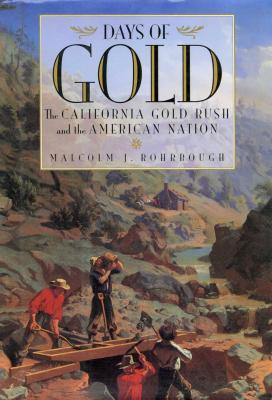 | Title: Days of gold: the California Gold Rush and the American nation Author: Rohrbough, Malcolm J Published: University of California Press, 1997 Subjects: History | California and the West | Californian and Western History | United States History | American Studies | Gender Studies Publisher's Description: On the morning of January 24, 1848, James W. Marshall discovered gold in California. The news spread across the continent, launching hundreds of ships and hitching a thousand prairie schooners filled with adventurers in search of heretofore unimagined wealth. Those who joined the procession - soon called 49ers - included the wealthy and the poor from every state and territory, including slaves brought by their owners. In numbers, they represented the greatest mass migration in the history of the Republic.In this first comprehensive history of the Gold Rush, Malcolm J. Rohrbough demonstrates that in its far-reaching repercussions, it was the most significant event in the first half of the nineteenth century. No other series of events between the Louisiana Purchase and the Civil War produced such a vast movement of people; called into question basic values of marriage, family, work, wealth, and leisure; led to so many varied consequences; and left such vivid memories among its participants.Through extensive research in diaries, letters, and other archival sources, Rohrbough uncovers the personal dilemmas and confusion that the Gold Rush brought. His engaging narrative depicts the complexity of human motivation behind the event and reveals the effects of the Gold Rush as it spread outward in ever-widening circles to touch the lives of families and communities everywhere in the United States. For those who joined the 49ers, the decision to go raised questions about marital obligations and family responsibilities. For those men - and women, whose experiences of being left behind have been largely ignored until now - who remained on the farm or in the shop, the absences of tens of thousands of men over a period of years had a profound impact, reshaping a thousand communities across the breadth of the American nation. [brief] Similar Items |
| 13. |  | Title: Dear Carnap, dear Van: the Quine-Carnap correspondence and related work Author: Carnap, Rudolf 1891-1970 Published: University of California Press, 1991 Subjects: Philosophy | History and Philosophy of Science | Autobiographies and Biographies Publisher's Description: Rudolf Carnap and W. V. Quine, two of the twentieth century's most important philosophers, corresponded at length - and over a long period of time - on matters personal, professional, and philosophical. Their friendship encompassed issues and disagreements that go to the heart of contemporary philosophic discussions. Carnap (1891-1970) was a founder and leader of the logical positivist school. The younger Quine (1908-) began as his staunch admirer but diverged from him increasingly over questions in the analysis of meaning and the justification of belief. That they remained close, relishing their differences through years of correspondence, shows their stature both as thinkers and as friends. The letters are presented here, in full, for the first time.The substantial introduction by Richard Creath offers a lively overview of Carnap's and Quine's careers and backgrounds, allowing the nonspecialist to see their writings in historical and intellectual perspective. Creath also provides a judicious analysis of the philosophical divide between them, showing how deep the issues cut into the discipline, and how to a large extent they remain unresolved. Dear Carnap, I enclose a copy of a paper which I am ready to send off for publication. . . . I am anxious to have you look this over as soon as possible, to see whether you have reason to suppose the system contradictory: for it looks dangerous. Dear Quine: I read your paper very carefully and with the highest interest. . . . So far, I do not see any contradiction in the system itself . . . but I share your feeling that the whole looks rather dangerous. [brief] Similar Items |
| 14. | 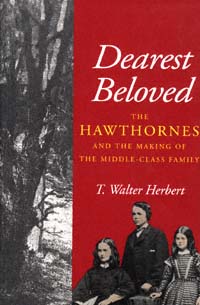 | Title: Dearest beloved: the Hawthornes and the making of the middle-class family Author: Herbert, T. Walter (Thomas Walter) 1938- Published: University of California Press, 1993 Subjects: Literature | American Literature | Literary Theory and Criticism | Women's Studies | Men and Masculinity | Autobiographies and Biographies | American Studies | United States History Publisher's Description: The marriage of Nathaniel and Sophia Hawthorne - for their contemporaries a model of true love and married happiness - was also a scene of revulsion and combat. T. Walter Herbert reveals the tragic conflicts beneath the Hawthorne's ideal of domestic fulfillment and shows how their marriage reflected the tensions within nineteenth-century society. In so doing, he sheds new light on Hawthorne's fiction, with its obsessive themes of guilt and grief, balked feminism and homosexual seduction, adultery, patricide, and incest. [brief] Similar Items |
| 15. | 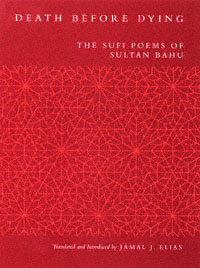 | Title: Death before dying: the Sufi poems of Sultan Bahu Author: Sult̤ān Bāhū 1630-1691 Published: University of California Press, 1998 Subjects: Literature | Religion | Poetry | Middle Eastern Studies | Literature in Translation | Islam | South Asia Publisher's Description: These 115 poems introduce readers in English to Sultan Bahu (d. 1691), a Sufi mystical poet who continues to be one of the most beloved writers in Punjabi. Bahu, whose name translates as "With God," remains highly popular in Pakistan and India today - even illiterate Punjabis can recite his poetry b . . . [more] Similar Items |
| 16. |  | Title: Death is that man taking names: intersections of American medicine, law, and culture Author: Burt, Robert 1939- Published: University of California Press, 2002 Subjects: Law | Health Care | History of Medicine | Ethics | Religion Publisher's Description: The American culture of death changed radically in the 1970s. For terminal illnesses, hidden decisions by physicians were rejected in favor of rational self-control by patients asserting their "right to die" - initially by refusing medical treatment and more recently by physician-assisted suicide. This new claim rested on two seemingly irrefutable propositions: first, that death can be a positive good for individuals whose suffering has become intolerable; and second, that death is an inevitable and therefore morally neutral biological event. Death Is That Man Taking Names suggests, however, that a contrary attitude persists in our culture - that death is inherently evil, not just in practical but also in moral terms. The new ethos of rational self-control cannot refute but can only unsuccessfully try to suppress this contrary attitude. The inevitable failure of this suppressive effort provokes ambivalence and clouds rational judgment in many people's minds and paradoxically leads to inflictions of terrible suffering on terminally ill people. Judicial reforms in the 1970s of abortion and capital punishment were driven by similarly high valuations of rationality and public decision-making - rejecting physician control over abortion in favor of individual self-control by pregnant women and subjecting unsupervised jury decisions for capital punishment to supposed rationally guided supervision by judges. These reforms also attempt to suppress persistently ambivalent attitudes toward death, and are therefore prone to inflicting unjustified suffering on pregnant women and death-sentenced prisoners. In this profound and subtle account of psychological and social forces underlying American cultural attitudes toward death, Robert A. Burt maintains that unacknowledged ambivalence is likely to undermine the beneficent goals of post-1970s reforms and harm the very people these changes were intended to help. [brief] Similar Items |
| 17. | 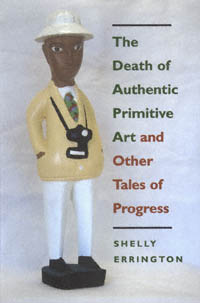 | Title: The death of authentic primitive art and other tales of progress Author: Errington, Shelly 1944- Published: University of California Press, 1998 Subjects: Anthropology | Cultural Anthropology | Art History | Architectural History | Art Theory Publisher's Description: In this lucid, witty, and forceful book, Shelly Errington argues that Primitive Art was invented as a new type of art object at the beginning of the twentieth century but that now, at the century's end, it has died a double but contradictory death. Authenticity and primitivism, both attacked by cultural critics, have died as concepts. At the same time, the penetration of nation-states, the tourist industry, and transnational corporations into regions that formerly produced these artifacts has severely reduced supplies of "primitive art," bringing about a second "death."Errington argues that the construction of the primitive in the nineteenth and twentieth centuries (and the kinds of objects chosen to exemplify it) must be understood as a product of discourses of progress - from the nineteenth-century European narrative of technological progress, to the twentieth-century narrative of modernism, to the late- twentieth-century narrative of the triumph of the free market. In Part One she charts a provocative argument ranging through the worlds of museums, art theorists, mail-order catalogs, boutiques, tourism, and world events, tracing a loosely historical account of the transformations of meanings of primitive art in this century. In Part Two she explores an eclectic collection of public sites in Mexico and Indonesia - a national museum of anthropology, a cultural theme park, an airport, and a ninth-century Buddhist monument (newly refurbished) - to show how the idea of the primitive can be used in the interests of promoting nationalism and economic development.Errington's dissection of discourses about progress and primitivism in the contemporary world is both a lively introduction to anthropological studies of art institutions and a dramatic new contribution to the growing field of cultural studies. [brief] Similar Items |
| 18. |  | Title: Death ritual in late imperial and modern China Author: Watson, James L Published: University of California Press, 1988 Subjects: History | China | Anthropology | Asian History Publisher's Description: During the late imperial era (1500-1911), China, though divided by ethnic, linguistic, and regional differences at least as great as those prevailing in Europe, enjoyed a remarkable solidarity. What held Chinese society together for so many centuries? Some scholars have pointed to the institutional control over the written word as instrumental in promoting cultural homogenization; others, the manipulation of the performing arts. This volume, comprised of essays by both anthropologists and historians, furthers this important discussion by examining the role of death rituals in the unification of Chinese culture. [brief] Similar Items |
| 19. |  | Title: Death Valley & the Amargosa: a land of illusion Author: Lingenfelter, Richard E Published: University of California Press, 1988 Subjects: History | California and the West | United States History Similar Items |
| 20. |  | Title: Decadent enchantments: the revival of Gregorian chant at Solesmes Author: Bergeron, Katherine Published: University of California Press, 1998 Subjects: Music | Musicology | French Studies | European History Publisher's Description: The oldest written tradition of European music, the art we know as Gregorian chant, is seen from an entirely new perspective in Katherine Bergeron's engaging and literate study. Bergeron traces the history of the Gregorian revival from its Romantic origins in a community of French monks at Solesmes, whose founder hoped to rebuild the moral foundation of French culture on the ruins of the Benedictine order. She draws out the parallels between this longing for a lost liturgy and the postrevolutionary quest for lost monuments that fueled the French Gothic revival, a quest that produced the modern concept of "restoration."Bergeron follows the technological development of the Gregorian restoration over a seventy-year period as it passed from the private performances of a monastic choir into the public commodities of printed books, photographs, and Gramophone records. She discusses such issues as architectural restoration, the modern history of typography, the uncanny power of the photographic image, and the authority of recorded sound. She also shows the extent to which different media shaped the modern image of the ancient repertory, an image that gave rise to conflicting notions not only of musical performance but of the very idea of music history. [brief] Similar Items |